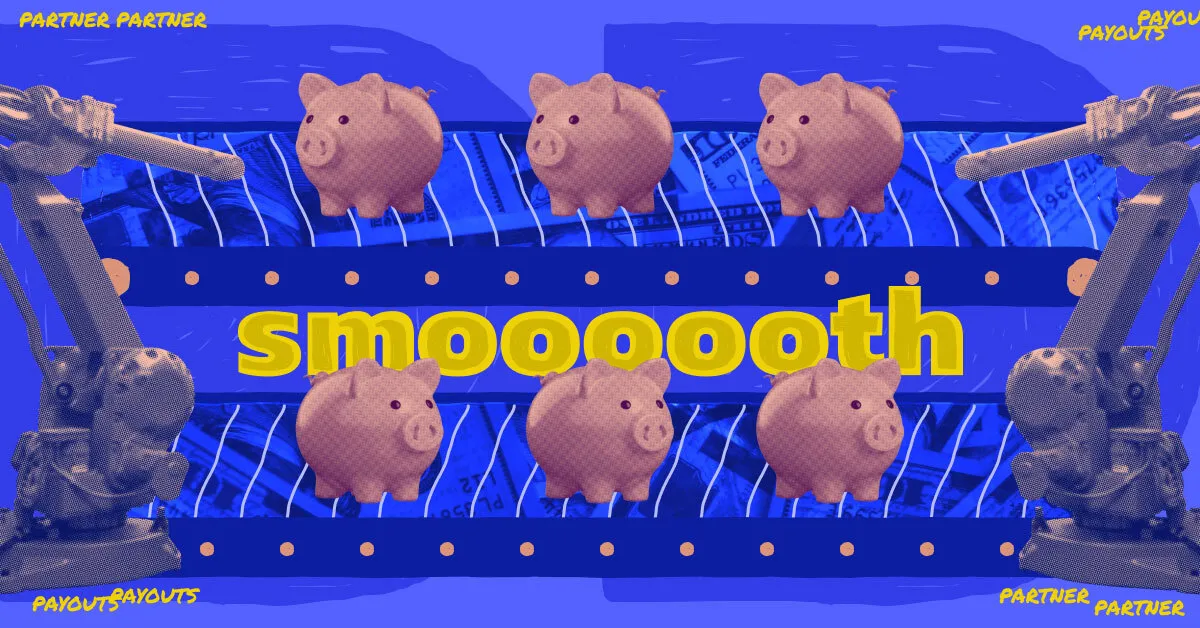Payments are perhaps the top priority for any successful partner program. Once your clever campaigns and incentive structures draw partners in, it’s the accuracy and timeliness of your payments that’ll get them to stay.
As a partner manager, you’re probably already on top of your payments, but just how much of your time is payments management taking up? And is there a better way to manage it all?
To find out, we chatted with Adam Faber, Customer Success Manager at PartnerStack, to find out how partner managers can better set their partnership programs up for success.
Audit current payroll processes
To start improving processes, it’s important to take stock of where you are today. Your current process may be heavily influenced by the size and maturity of your current partnership programs.

If you have a smaller program, you may be handling your payments manually, by keeping track of what your partners sell and then sending the amounts owing to your accounts payable team every month. While this may work in the beginning, it’s a good idea to move towards an integrated system that tracks incentives, activity and payments across your entire partner program. This way, your partner program relies on more than blind trust.
“The real advantage of PartnerStack is the built-in accountability,” explains Faber. “If I’m a partner, I can see what is going on with the traffic I drive. I’m looking at my dashboard, and I can see that I’ve earned $125.”
Identify efficiencies in payroll processes
This approach also allows partners to examine their entire funnel. A partner may drive dozens of signups for a service, but only receive a fraction of that amount in commissions. Instead of doubting the accuracy of a partner’s system or asking the partner to manually generate a report, they can go into their dashboard and view all of the customers they’ve encouraged to sign up and how many have actually paid. This creates overall efficiency, so you’re fielding fewer payments and fewer questions.
Identify areas needing improvement
Beyond creating efficiencies, it’s also key to watch out for the major pitfalls to avoid when it comes to your partner program’s payouts. These could look like:
- Relying on manual processes
- Not understanding what’s valuable to your business
- Not looping in financial controllers or other auditors in advance
- Ensuring compliance with payroll regulations in 2024
- Underestimating how much you may have to pay out to partners
Embrace payroll technology
The beauty of an automated system is that it’ll do exactly what you tell it to do. The curse of an automated system is that it’ll do exactly what you tell it to do – even if you meant something else.
To avoid this trap, it’s important to answer:
- What is most valuable to the business?
- What are the partner incentives or commission structure?
- Who needs to review outgoing funds?
Let’s dive into each of these functions and how embracing automated payroll technology can answer them.
Related: Here’s how business automation saves you time and money.
Understand what is most valuable to the business
Much of the time, partner programs focus on driving new paying customers. For every customer signup, a company is willing to pay a specific commission to the partner. But depending on your business, there may be other actions that you wish to incentivize. Faber explains how this works and how an automated solution, especially one with PartnerStack’s APIs, can help streamline this strategy.
“Maybe I want to pay out on someone signing up for a free trial,” says Faber. “No money has changed hands, and I don’t want to pay [for] someone just giving me their email address. That’s way too easy. That’s way too low a bar. So this particular client says, ‘When you make a free account with us and we do two-factor authentication on your phone, that’s the point where we want to pay because we know that’s when a customer is real.’”
It’s important to identify what’s valuable for your business, depending on your acquisition strategy and your budget. In a high-trust industry like banking, simply getting someone to sign up might be a difficult proposition, and so this may be a behavior that a company wants to incentivize. There are other activities that your organization can create commissions for, such as signing up for a demo. It all depends on the business and which actions tend to lead to more closed-won deals.
See more: Effective SaaS OKR strategies to implement for 2024.
Review partner payout agreements
The payment commission structures in partner agreements are typically:
- Revenue-sharing model: For every customer signup, the vendor will pay a set commission to the partner (for example, 20 per cent of a yearly subscription fee).
- Flat structure model: For every customer signup, the vendor will pay the partner a flat reward (for example, $100 per signup).
- Month-to-month commission model: If the customer signs up for a month-to-month billing model, the commissions would be divided accordingly (for example, a one-year subscription in which the partner is paid 30 per cent of the subscription for each month, rather than a lump sum for the entire year-long subscription).
If you’re working with an automated solution, it’s important to be clear about what triggers a payment, so that payments are predictable and processed in a timely manner. For instance, the PartnerStack system pays partners on the twelfth of every month.
“Your partner commission invoice is generated every month,” Faber explains. “You have one week to look at it. We assume no news is good news. If you don’t have any objections, everything is fine, and we pass those commissions through to your payment method on file.”
Conduct compliance check for partner payouts
Finally, you’ll need to identify whether there are people who want to review your outgoing partner commissions. This is especially true once you’ve automated the process, as Faber explains.
“I would be informing my financial controller, ‘You’ve gotta either get your own log in and come in and check between the first and the seventh each month, or I will just download it and send you an invoice – the CSV – at the beginning of each month, and you can take a look at it that way.’ The system assumes you approve. If not, you need to click a button that says, ‘no.’”
In addition, Faber also advises making sure that you have the funds available. There are instances in which a partner can over-perform – which is wonderful news! – but if you’ve connected a card with a lower limit to your account, this may prevent that superstar from getting paid.
The good news with PartnerStack’s PRM is you’ll never be paying money you haven’t received, unless you’re paying for a non-monetary activity such as a signup.
“We pay the partner when the customer gives you the money,” explains Faber. “So the commissions are generated when the money hits the company’s account. If you’ve got someone on a monthly payment plan, that means the partner is earning monthly commissions. If you’ve got them on an annual payment plan, that means the partner is earning annual commissions.”

Action plan for payroll success
On the face of it, payments are a pretty straightforward concept. The partner makes a sale or other incentivized action occur, and they’re paid a nice commission as a result. But if you’ve already got your payments process sorted, there are ways to start viewing payment strategically – both for your partnership programs and the partner manager.
See more: What partner managers should look for before closing a deal.
Generate campaigns based on a partner’s transaction volume
One of the most powerful parts of using a PRM and automating your payments is that you can focus on the partners that bring in the most revenue without neglecting your smaller partners.
In previous articles, we’ve talked about the importance of maintaining partner engagement throughout their time in the program, so that they’re aware of new resources and campaigns. Faber explains that it’s also worth developing a communications strategy for partners who are doing a great job.
“If your partner has driven enough revenue for you or enough clicks for you or enough free signups for you, you can communicate with them based on how well they’re doing,” he says. “You can send them specific emails like, ‘Wow you got a 1000 clicks, great job!’ or ‘Hey, you got your first ten paying customers.’ Or you can drop them a congratulations email or a follow-up email inviting them to get on a call with you and talk about more ways they could earn.”
Another strategy Faber recommends is multiple payment tiers. For instance, tier one partners may be able to earn a 20 per cent commission on specific sales activities. Once they pass a certain dollar value of sales and get to the second tier, they may be eligible for a 25 per cent commission.
Use an understanding of payments to secure more budget and advance in your company
As a partner manager, there are also opportunities for you to advance your career and increase your budget by:
- Understanding what your company values
- Demonstrating the impact of a referral or commissions program
Organizations allocate money to specific activities such as content marketing or paid advertising. The activities that generate the most results get more money in next year’s budget. Use this understanding to bring more money to partnerships – and secure your seat at the table.
“If something is working within the paid advertising team and they’re spending a million dollars on Facebook ads and it works, they don’t think twice about cranking it up to $2 million,” says Faber. “You could unlock those same budgets. All you’ve got to do is learn what it is the company cares about. Cost per click? Average cost of acquisition? What’s the deal here? What is actually being measured?”
Faber recommends understanding why certain decisions are being made, so you can unlock new opportunities. For instance, if your executive leadership team green lights a $50 reward for every new customer that comes in, take the time to understand where this number is coming from. “Find out why,” Faber encourages. “Don’t be afraid to ask.”
Following these best practices for partner payouts and ensuring that you have alignment with company goals for the year will make your 2024 payroll processes all the more effective.

















